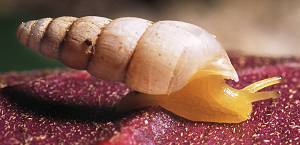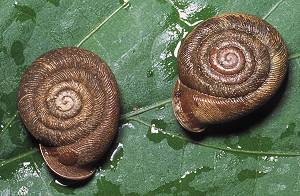Tropical Land Snail Diversity: Sri Lanka
Sri Lanka

Eutomopeas layardi, endemic to Sri Lanka, with a small high spired shell and bright yellow body is typical of the family Subulinidae.
Supported by the Darwin Initiative we are building on our earlier projects with conservation work in Sri Lanka that we hope will serve as a model for developing our projects in South and Southeast Asia.
The first task on our 1999 - 2002 Sri Lankan project was to compile an illustrated land snail species list for Sri Lanka. This was our starting point for assembling current knowledge and was published as a book in 2000. Shells and, where available, type specimens, were photographed by Harold Taylor in Image Resources at the NHM, largely from the NHM collections. Additional material was borrowed from the Zoological Museum, University of Cambridge, which holds the main collections of William Benson, Muséum National d'Histoire Naturelle, Paris, Museum für Naturkunde der Humbolt-Universität, Berlin, Zoologisk Museum, Copenhagen and the Muséum d'Histoire Naturelle, Geneva.

Known from ten species in Sri Lanka and a single species in India, Corilla is an ancient genus dating from the age of dinosaurs.
Jim Chimonides, Department of Zoology, prepared an interactive version that was also published on compact disc in 2000. In this trial version a few links to facsimiles of the primary literature were added. Lack of access to the literature is a major constraint for biologists working in developing countries and we wanted to explore the feasibility of adding an extensive literature resource to the CD. A considerable amount of effort has since been expended on scanning the primary literature for inclusion in a future edition. The status of some of the taxa is being revised and some fifty new species and several new genera need to be added. Addition of this information must await formal publication elsewhere but as this is an ongoing process the interactive resource can be updated in stages.
This work was developed in our 2003-2005 project to investigate a wide range of questions. These included the origin of the fauna, its history, current threats, particularly the impact of forest loss and fragmentation, conservation strategy and future prospects.
The ecological investigations focus on the impact of rainforest fragmentation and the importance of different types of human transformed habitats as reservoirs of native species. These transformed habitats range from the traditional home gardens that retain a significant component of endemic species to intensively cultivated cash crops where native snails may be completely absent and high densities of exotic species occur.
This work was carried out jointly with Richard Preece at the University Museum of Zoology Cambridge and in collaboration with the Termite Research Group and Soil Biodiversity Programme at the Natural History Museum, led by Paul Eggleton.